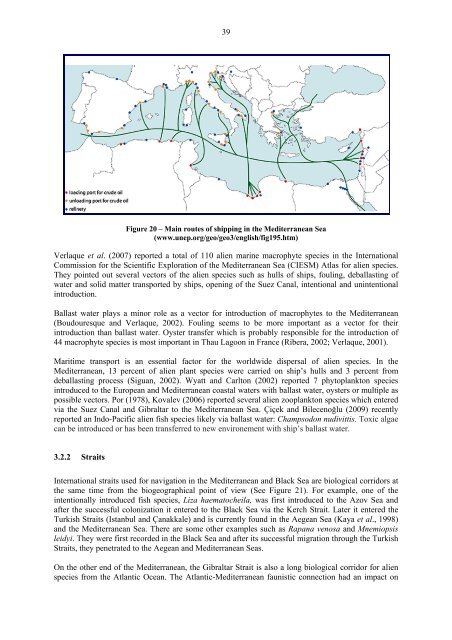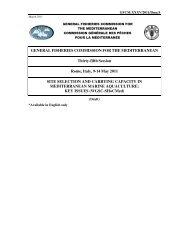Status of alien species in the Mediterranean and Black Sea
Status of alien species in the Mediterranean and Black Sea
Status of alien species in the Mediterranean and Black Sea
You also want an ePaper? Increase the reach of your titles
YUMPU automatically turns print PDFs into web optimized ePapers that Google loves.
39<br />
Figure 20 – Ma<strong>in</strong> routes <strong>of</strong> shipp<strong>in</strong>g <strong>in</strong> <strong>the</strong> <strong>Mediterranean</strong> <strong>Sea</strong><br />
(www.unep.org/geo/geo3/english/fig195.htm)<br />
Verlaque et al. (2007) reported a total <strong>of</strong> 110 <strong>alien</strong> mar<strong>in</strong>e macrophyte <strong>species</strong> <strong>in</strong> <strong>the</strong> International<br />
Commission for <strong>the</strong> Scientific Exploration <strong>of</strong> <strong>the</strong> <strong>Mediterranean</strong> <strong>Sea</strong> (CIESM) Atlas for <strong>alien</strong> <strong>species</strong>.<br />
They po<strong>in</strong>ted out several vectors <strong>of</strong> <strong>the</strong> <strong>alien</strong> <strong>species</strong> such as hulls <strong>of</strong> ships, foul<strong>in</strong>g, deballast<strong>in</strong>g <strong>of</strong><br />
water <strong>and</strong> solid matter transported by ships, open<strong>in</strong>g <strong>of</strong> <strong>the</strong> Suez Canal, <strong>in</strong>tentional <strong>and</strong> un<strong>in</strong>tentional<br />
<strong>in</strong>troduction.<br />
Ballast water plays a m<strong>in</strong>or role as a vector for <strong>in</strong>troduction <strong>of</strong> macrophytes to <strong>the</strong> <strong>Mediterranean</strong><br />
(Boudouresque <strong>and</strong> Verlaque, 2002). Foul<strong>in</strong>g seems to be more important as a vector for <strong>the</strong>ir<br />
<strong>in</strong>troduction than ballast water. Oyster transfer which is probably responsible for <strong>the</strong> <strong>in</strong>troduction <strong>of</strong><br />
44 macrophyte <strong>species</strong> is most important <strong>in</strong> Thau Lagoon <strong>in</strong> France (Ribera, 2002; Verlaque, 2001).<br />
Maritime transport is an essential factor for <strong>the</strong> worldwide dispersal <strong>of</strong> <strong>alien</strong> <strong>species</strong>. In <strong>the</strong><br />
<strong>Mediterranean</strong>, 13 percent <strong>of</strong> <strong>alien</strong> plant <strong>species</strong> were carried on ship’s hulls <strong>and</strong> 3 percent from<br />
deballast<strong>in</strong>g process (Siguan, 2002). Wyatt <strong>and</strong> Carlton (2002) reported 7 phytoplankton <strong>species</strong><br />
<strong>in</strong>troduced to <strong>the</strong> European <strong>and</strong> <strong>Mediterranean</strong> coastal waters with ballast water, oysters or multiple as<br />
possible vectors. Por (1978), Kovalev (2006) reported several <strong>alien</strong> zooplankton <strong>species</strong> which entered<br />
via <strong>the</strong> Suez Canal <strong>and</strong> Gibraltar to <strong>the</strong> <strong>Mediterranean</strong> <strong>Sea</strong>. Çiçek <strong>and</strong> Bilecenoğlu (2009) recently<br />
reported an Indo-Pacific <strong>alien</strong> fish <strong>species</strong> likely via ballast water: Champsodon nudivittis. Toxic algae<br />
can be <strong>in</strong>troduced or has been transferred to new environement with ship’s ballast water.<br />
3.2.2 Straits<br />
International straits used for navigation <strong>in</strong> <strong>the</strong> <strong>Mediterranean</strong> <strong>and</strong> <strong>Black</strong> <strong>Sea</strong> are biological corridors at<br />
<strong>the</strong> same time from <strong>the</strong> biogeographical po<strong>in</strong>t <strong>of</strong> view (See Figure 21). For example, one <strong>of</strong> <strong>the</strong><br />
<strong>in</strong>tentionally <strong>in</strong>troduced fish <strong>species</strong>, Liza haematocheila, was first <strong>in</strong>troduced to <strong>the</strong> Azov <strong>Sea</strong> <strong>and</strong><br />
after <strong>the</strong> successful colonization it entered to <strong>the</strong> <strong>Black</strong> <strong>Sea</strong> via <strong>the</strong> Kerch Strait. Later it entered <strong>the</strong><br />
Turkish Straits (Istanbul <strong>and</strong> Çanakkale) <strong>and</strong> is currently found <strong>in</strong> <strong>the</strong> Aegean <strong>Sea</strong> (Kaya et al., 1998)<br />
<strong>and</strong> <strong>the</strong> <strong>Mediterranean</strong> <strong>Sea</strong>. There are some o<strong>the</strong>r examples such as Rapana venosa <strong>and</strong> Mnemiopsis<br />
leidyi. They were first recorded <strong>in</strong> <strong>the</strong> <strong>Black</strong> <strong>Sea</strong> <strong>and</strong> after its successful migration through <strong>the</strong> Turkish<br />
Straits, <strong>the</strong>y penetrated to <strong>the</strong> Aegean <strong>and</strong> <strong>Mediterranean</strong> <strong>Sea</strong>s.<br />
On <strong>the</strong> o<strong>the</strong>r end <strong>of</strong> <strong>the</strong> <strong>Mediterranean</strong>, <strong>the</strong> Gibraltar Strait is also a long biological corridor for <strong>alien</strong><br />
<strong>species</strong> from <strong>the</strong> Atlantic Ocean. The Atlantic-<strong>Mediterranean</strong> faunistic connection had an impact on
















